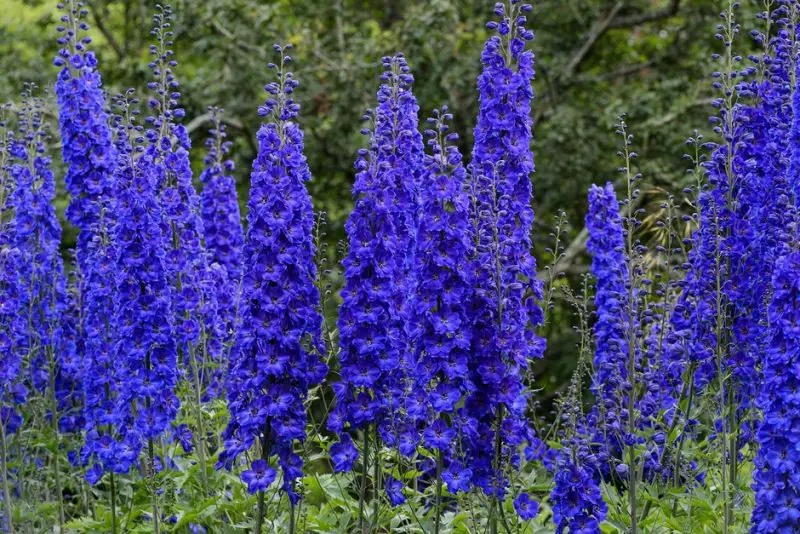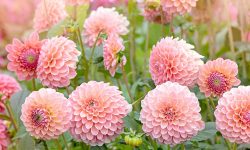Delphiniums are among the most captivating perennials gardeners can grow. Their tall, spiky blooms and rich shades of blue, purple, pink, and white bring striking vertical interest to any garden. However, they are also known for being a bit finicky. Learning how to grow delphinium in every climate requires understanding their specific needs in varying temperature zones and tailoring care accordingly. With the right guidance, anyone can achieve spectacular blooms regardless of where they live.
This comprehensive guide will walk you through everything you need to know about how to grow delphinium in all climates. From choosing the right variety and preparing your soil to seasonal care tips and troubleshooting, you’ll be ready to enjoy these dramatic flowers in your garden year after year.
Choosing the Right Delphinium Varieties for Your Climate

Selecting the right delphinium variety is crucial for achieving lasting blooms across diverse climates. In cooler zones such as USDA Zones 3–6, tall hybrid types like the Pacific Giants or Magic Fountains thrive thanks to their cold tolerance and preference for mild summers. These cultivars grow strong in regions with well-defined winters, and their tall spires can easily reach 4 to 6 feet with proper care.
For warmer zones such as USDA Zones 7–9, gardeners should look for heat-tolerant selections. Although delphinium generally prefers cooler conditions, shorter varieties like ‘Connecticut Yankees’ or the ‘Delphina’ series perform better in milder winters and withstand early summer heat better than taller types. These varieties may bloom for a shorter time in the peak of summer but can often re-bloom in fall if pruned correctly.
In coastal or high-humidity climates, mildew-resistant cultivars are the best choice to prevent disease. Look for newer hybrids bred specifically for better fungal resistance if you’re gardening in a damp or rainy region. Understanding the microclimate in your garden—whether it’s dry and sunny or humid and shaded—can help you match the variety to the conditions and avoid stress-related blooming issues.
Preparing the Planting Site
Delphiniums are heavy feeders that demand rich, fertile, and well-drained soil to perform their best. Start by selecting a site with loamy soil enriched with compost or well-rotted manure. Before planting, work organic matter into the top 12 inches of soil to enhance its structure and water retention while improving drainage.
Soil pH is another important factor. Delphiniums prefer slightly alkaline soil in the range of 6.5 to 7.5. If your soil is too acidic, consider incorporating lime to raise the pH gradually over several months before planting. A soil test can guide you in determining whether amendments are needed and help you avoid nutrient imbalances that could hinder blooming.
Drainage is critical. While delphiniums need consistent moisture, they hate soggy roots. Raised beds or mounded rows can be useful in heavy clay areas. In sandy soils, more frequent watering and organic matter can help retain enough moisture for healthy growth. Mulching around the base with composted bark or leaf mold will suppress weeds, maintain even moisture levels, and enrich the soil over time.
Planting Delphinium for Strong Growth and Healthy Blooms
Timing and technique play essential roles in successful planting. In cold climates, plant delphinium in early spring after the danger of hard frost has passed. For milder climates, fall planting allows roots to establish before summer heat arrives. Whether starting from seed, transplants, or bareroot divisions, spacing is key—place plants 18 to 24 inches apart to promote airflow and reduce fungal problems.
When planting, dig a hole twice the width of the root ball and mix compost or balanced slow-release fertilizer into the backfill soil. Set the crown of the plant just at or slightly above ground level. Water thoroughly after planting to eliminate air pockets and help roots settle in.
For bareroot delphiniums, soak roots in water for an hour before planting to rehydrate. Spread the roots out gently in the hole and cover with soil. Water well and apply a layer of mulch to protect the crown and retain soil moisture. Avoid planting too deep, as this can cause the crown to rot.
Supporting Delphinium Spikes Against Wind and Rain
Tall delphiniums are stunning but structurally weak when faced with wind or heavy rain. Staking is essential to keep flower spikes upright and prevent breakage. Start staking early in the season—ideally when plants are 12 to 18 inches tall—to avoid disturbing roots later.
Use bamboo canes, metal rings, or wooden stakes placed just behind the plant. Tie the stems loosely with soft twine, plant ties, or stretchable garden tape. As the plant grows, add additional ties every 12 to 18 inches up the stem to provide full support without restricting growth.
In areas prone to storms or gusty wind, group plants close together and provide shelter using fences, hedges, or windbreaks. If delphiniums are grown in containers, position the pots near walls or trellises to reduce wind exposure. Regularly check support structures and adjust ties to prevent girdling as stems thicken.
Fertilizing for Stronger Delphinium Growth
Choosing the Right Fertilizer Formula
Delphiniums require nutrient-rich soil to thrive, and the right fertilizer can make a significant difference in both plant health and flower production. A balanced or slightly phosphorus-rich formula, such as 10-20-10, works best to encourage strong root systems and tall, vibrant flower spikes. Granular slow-release fertilizers provide consistent feeding over time, which is ideal during the long growing season. If you prefer organic options, well-aged compost, composted manure, or diluted fish emulsion are gentle on the roots and improve overall soil structure. It’s important to avoid high-nitrogen fertilizers, as they often lead to excessive leafy growth at the expense of flower formation.
Timing Your Feeding Schedule
Feeding delphiniums at the right time ensures they have the nutrients they need at key stages of development. Begin fertilizing in early spring as soon as you see new shoots emerging. This early application supports root expansion and healthy foliage. A second feeding should be timed with the formation of the first flower buds to promote abundant blooms. After deadheading the initial bloom, a mid-summer application can stimulate a secondary flowering. In cold climates, stop fertilizing by the end of August to avoid stimulating late-season growth that may be damaged by frost. However, in warmer regions, an additional light feeding into early autumn can support extended blooming into the fall months.
Applying Fertilizer Properly
Proper application ensures nutrients reach the roots efficiently without harming the plant. For granular fertilizers, sprinkle the product evenly around the plant’s base, keeping it 4 to 6 inches away from the crown to prevent rot, and water thoroughly after application. For liquid fertilizers, make sure the soil is moist before feeding to minimize root burn, especially during hot weather. Apply directly to the soil rather than the foliage. Always read and follow the fertilizer label instructions, as overuse can lead to nutrient imbalances or salt buildup, particularly in container-grown delphiniums. Monitoring plant response over time will help you fine-tune your fertilizing routine for best results.
Watering Techniques That Support Healthy Blooms
How Much Water Does Delphinium Need?
Delphiniums thrive in consistently moist, well-draining soil, particularly during their active growth and blooming phases. On average, they require about one inch of water per week, though this can vary depending on climate and soil conditions. In regions with sandy or fast-draining soils, or during periods of hot, windy weather, they may need more frequent watering—sometimes two to three times a week. Rather than watering on a strict schedule, check the top inch of soil; if it feels dry to the touch, it’s time to water. Be cautious not to overwater, as delphinium roots are prone to rot when left in soggy soil.
When to Water for Optimal Growth
Timing your watering correctly enhances both water efficiency and plant health. Early morning is the ideal time to water delphiniums because it allows moisture to soak deeply into the soil before daytime heat increases evaporation. This timing also gives the foliage enough time to dry before nightfall, which helps prevent powdery mildew, rust, and other moisture-related diseases. During extremely hot days or in containers, delphiniums may benefit from a second light watering in the late afternoon—just be sure leaves dry quickly to avoid fungal issues. Regular observation of your garden’s microclimate is key to determining the best schedule.
Techniques to Improve Water Absorption
Efficient watering techniques help delphiniums absorb moisture more effectively and reduce waste. Start by applying a 2–3 inch layer of organic mulch—such as shredded bark, straw, or compost—around the base of each plant, taking care to keep mulch away from the crown to avoid rot. This layer helps retain soil moisture, regulate temperature, and suppress weeds that compete for water. For targeted hydration, install drip irrigation or soaker hoses to deliver water directly to the root zone, minimizing splashing that can spread disease. In heavier soils, consider amending with compost or sand to improve drainage and prevent standing water. Periodically aerate the soil around mature plants to reduce compaction and ensure water penetrates deeply rather than running off the surface.
Pruning and Deadheading to Extend Bloom Time
The Importance of Deadheading
Deadheading delphiniums is essential for both aesthetics and plant health. When faded flowers are left on the plant, energy is directed into seed production, which slows or halts the development of new blooms. Removing these spent flowers encourages the plant to continue producing buds and extends the flowering period.
It’s important to deadhead regularly — ideally as soon as the blooms begin to fade. Delphinium flowers grow on tall spikes, so begin at the top and work your way down, cutting just above a leaf node or lateral bud. This encourages side shoots to develop, which often produce smaller, but still vibrant, blooms. Deadheading also helps prevent self-seeding, which can lead to overcrowding in future seasons.
For best results, always use clean, sharp pruning shears. Disinfect tools between plants to prevent the spread of disease, especially if you notice any signs of fungal or bacterial infection on the foliage or stems.
Cutting Back After the First Bloom
Once the tall, showy flower spikes begin to wither completely after the first major bloom, it’s time for more substantial pruning. Cut the entire flower stalk down to the base of the plant or to the first strong set of basal leaves. This signals to the plant that it should focus on regrowth rather than seed formation.
Delphiniums in cooler climates often respond to this cutback by producing a second flush of blooms in late summer or early fall. This second round may not be as tall or dense as the first, but it still brings vibrant color and adds interest to the late-season garden. In warmer areas, regular cutting and attentive watering may result in continuous flowering throughout the summer into early autumn.
Adding a balanced, low-nitrogen fertilizer after cutting back can support this secondary bloom. Mulching again at this stage can also help retain moisture and protect roots during regrowth.
Pruning in Fall or Early Spring
Fall pruning plays a crucial role in maintaining a healthy delphinium plant over winter. After the first frost kills the top growth and the plant begins to enter dormancy, prune all stems back to about two inches above the ground. This not only tidies up the garden but also eliminates hiding places for pests such as slugs, earwigs, and overwintering larvae.
Dispose of the cut foliage away from the garden to prevent disease recurrence in the next growing season. If your garden experiences wet winters, consider applying a light mulch to insulate the crown from freeze-thaw cycles without encouraging rot.
In early spring, inspect the base of each plant as it breaks dormancy. Remove any mushy or dead stems left from winter and clear away any debris from around the base. At this time, you can also thin out weak shoots to ensure that only the strongest stems grow upward, which will support larger blooms and stronger stalks.
Regular pruning through the seasons not only keeps your delphiniums looking their best but also strengthens their performance year after year, promoting larger blooms, healthier foliage, and an overall more vibrant garden display.
Supporting Tall Stems to Prevent Flopping
Why Staking Is Essential
Delphiniums can grow over six feet tall, and their flower spikes are often top-heavy. Without support, they’re vulnerable to wind damage and may topple over during rainstorms. Even in sheltered gardens, staking is recommended to keep the plants upright and ensure full display of blooms. This not only protects the stems from breakage but also prevents blooms from coming into contact with wet soil, which can cause spotting, fungal infections, and premature wilting. Proper staking enhances both plant health and aesthetic appeal, making your garden look neat and professionally maintained.
Types of Plant Supports to Use
You can use bamboo stakes, metal cages, or commercial flower rings to support delphiniums. For tall varieties, a grid or ring system installed early in the season is often best, allowing the stems to grow through and be supported naturally. Tie stems loosely with soft garden twine to avoid constriction. Tomato cages or customized hoop supports can also be effective, especially for gardeners in windy regions. For heavier varieties, consider using three or four stakes per plant and securing the stems in a tripod-like configuration to evenly distribute weight and avoid leaning. Choose weather-resistant materials for longer-lasting results season after season.
When and How to Stake Effectively
Stake delphiniums when they reach about one foot tall — before flower buds form. This early intervention prevents the plant from leaning and helps guide vertical growth. Position the stakes slightly behind the plant and tie the main stem and any secondary stalks loosely using soft ties such as jute, twine, or stretchable plant tape. Avoid rigid wire or string that could damage stems as they expand. As the plant grows, revisit your supports every one to two weeks to adjust ties and add more if needed. Be sure the ties are secure but flexible to allow natural swaying with the wind, which strengthens the stems while reducing breakage risk.
Troubleshooting Common Problems with Delphinium
Yellowing Leaves and What They Mean
When delphinium leaves turn yellow, it often signals an underlying issue with water, nutrients, or soil conditions. The first step is to assess soil moisture. Delphiniums are highly sensitive to overwatering and poor drainage. If the roots sit in soggy soil for too long, they begin to rot, preventing the plant from absorbing nutrients properly. In this case, amend the soil with organic matter like compost or relocate the plant to a raised bed or container with better drainage.
However, if the soil is dry and crumbly, underwatering may be the problem. Delphiniums require consistent moisture, especially during active growth and blooming. Adjust your watering schedule so that the soil remains evenly moist but not wet. Another common cause is nutrient deficiency — particularly nitrogen, magnesium, or iron. If the yellowing appears mainly on older leaves, it’s often a sign of nitrogen shortage. Use a balanced fertilizer with added trace minerals to restore color and vitality. Regular feeding during the growing season will support lush foliage and strong flower stalks.
Black Spot and Powdery Mildew Prevention
Delphiniums are especially vulnerable to fungal infections like black spot and powdery mildew, which thrive in damp, stagnant air or when foliage remains wet for extended periods. These diseases can cause unsightly leaf spotting, a powdery white coating, and eventual leaf drop, weakening the entire plant. To reduce the risk, always space plants widely enough to encourage air circulation. This allows the leaves to dry quickly after rain or watering.
Avoid overhead watering, which keeps the foliage moist and promotes fungal growth. Instead, water at the base early in the morning so any moisture on leaves can evaporate quickly. At the first sign of infection, remove affected leaves and dispose of them away from your compost pile. Preventative treatments with neem oil, sulfur sprays, or copper-based fungicides can help keep fungi at bay without harming bees or beneficial insects. It’s especially important to spray before extended rainy periods or during warm, humid weather, when fungal conditions are most likely to spread rapidly.
Managing Aphids and Slugs
Aphids and slugs are two of the most common pests that target delphiniums. Aphids typically appear in early spring and gather in clusters on tender stems, new leaves, and flower buds. These pests suck out sap, causing deformed growth, stunted flowering, and even virus transmission. You can physically dislodge them with a strong spray of water or use insecticidal soap to control large infestations without harming pollinators. Encouraging natural predators like ladybugs or lacewings can also keep aphid populations under control in an eco-friendly way.
Slugs and snails are especially problematic in shaded gardens or during damp weather. They feed at night, leaving behind irregular holes in leaves and silvery trails. Young delphinium shoots are particularly vulnerable and can be eaten down to the ground. To protect your plants, apply barriers such as copper tape around containers, or scatter diatomaceous earth or crushed eggshells around the base of plants. Beer traps or iron phosphate pellets can also be used, especially during periods of heavy rain. Check for slugs in the early morning or evening and remove them by hand to reduce long-term damage.
Overwintering Delphinium for Year-Round Success
Proper overwintering ensures delphiniums return stronger each spring. In cold climates (zones 3–6), once the first hard frost hits, cut back the stems close to the ground to prevent disease and rot. Apply a thick, breathable mulch such as straw, pine needles, or shredded bark around the crown to protect the roots from extreme cold and freeze-thaw cycles. This also stabilizes soil temperature and helps prevent frost heave that can push the plant out of the ground.
In areas with mild winters (zones 7–9), delphiniums may stay semi-evergreen. Remove yellow or dying leaves but leave healthy foliage intact to support the plant’s energy reserves. A light mulch layer still helps conserve soil moisture, suppress weeds, and buffer against sudden cold snaps. Water occasionally if the soil is dry to the touch, but avoid overwatering during dormancy, which can lead to root rot.
As spring approaches, gradually remove mulch as temperatures rise and new shoots begin to emerge. Rushing this process can expose tender growth to late frosts, so watch the weather and wait for consistent warming. Once the plant resumes active growth, resume watering more regularly and apply a slow-release fertilizer to give it a strong start to the season. With proper winter care, delphiniums can thrive year after year, even in regions with challenging climates.
Dividing and Propagating Delphinium
When and Why to Divide Plants
Dividing delphiniums every three to five years is essential for maintaining plant vigor, promoting healthier foliage, and encouraging more abundant flowering. As delphinium clumps age, the center often dies out or becomes woody, while outer shoots may crowd one another, reducing airflow and leading to disease or poor blooming. By dividing, you not only revitalize declining plants but also multiply your stock at no extra cost.
The ideal times for division are early spring—just as new growth begins to emerge—or in late summer or early fall, after flowering has finished but before the first frost. This allows the divisions enough time to settle in and establish roots before facing seasonal extremes.
How to Divide Successfully
To divide a mature delphinium plant successfully, start by preparing the new planting sites ahead of time with rich, well-draining soil amended with compost or organic matter. On a cool day, gently dig around the plant with a sharp spade or garden fork, working in a wide circle to preserve as much of the root system as possible. Once lifted, shake off excess soil and carefully examine the crown.
Use a clean, sharp knife or hand tool to cut the root ball into sections. Each division should have at least one strong crown with several leaf buds and a healthy root system. Discard any dead or rotted sections. Replant each division immediately at the same soil level it was growing before. Space them at least 18 inches apart to give them room to grow. Water thoroughly after planting and apply a light mulch to keep the soil moist and reduce stress while the roots re-establish.
Propagating from Cuttings or Seeds
In addition to division, delphiniums can be propagated from basal cuttings or grown from seeds—both are cost-effective methods to expand your garden. Basal cuttings are best taken in early spring when new shoots are 3 to 4 inches tall and still soft. Use a sharp blade to remove the shoot near the base, making sure it includes a small portion of the root crown tissue. Dip the base in rooting hormone to encourage quicker root development and place the cutting in a sterile, moist growing medium like perlite or a sand-peat mix. Keep it in a warm, bright spot with indirect light and high humidity until roots form, usually within 3–4 weeks.
Growing delphiniums from seed offers genetic variety, but many hybrid cultivars may not produce offspring true to the parent plant. For best results, start seeds indoors 8 to 10 weeks before your last expected frost date. Chill the seeds in the refrigerator for 1–2 weeks before sowing to break dormancy, then plant them in a seed-starting mix and keep them at around 65–70°F. Germination may take 2–3 weeks. Once seedlings have developed true leaves, transplant them into larger pots and gradually harden them off before moving outdoors.
FAQ About Planting Delphiniums
What is the best location to plant delphiniums for optimal blooming?
Delphiniums thrive in full sun with rich, well-draining soil. Ideally, choose a spot that receives at least 6 hours of direct sunlight each day, especially in cooler regions. In hotter climates, some afternoon shade can help prevent the flower spikes from wilting. Make sure the area is sheltered from strong winds, which can snap tall flower stalks. Adding organic matter to the soil before planting improves drainage and gives delphiniums a strong start.
How often should I water delphiniums?
Delphiniums require consistent moisture, especially during their active growing and blooming periods. Water deeply once or twice a week, depending on weather and soil conditions. Avoid shallow, frequent watering, which can encourage surface roots and weak growth. It’s important not to overwater, as soggy soil can lead to root rot. During dormancy or cooler weather, reduce watering but don’t let the soil completely dry out.
Why are my delphinium leaves turning yellow or brown?
Yellowing or browning leaves on delphiniums often point to stress from poor drainage, overwatering, or nutrient deficiencies. Check that your soil drains well and isn’t waterlogged. If the problem is lower leaves yellowing while the rest of the plant is healthy, it may be natural aging. However, widespread discoloration can signal fungal issues or a need for feeding. Apply a balanced fertilizer in early spring and mid-season to keep foliage green and vibrant.
Can delphiniums survive frost or snow?
Yes, most delphinium varieties are hardy perennials in USDA zones 3–7 and can tolerate frost and snow with proper winter care. In colder regions, cut back stems after the first frost and apply a thick mulch layer around the crown to protect roots from freeze-thaw damage. In milder areas, the plants may retain green growth and need only light pruning and minimal mulch. Delphiniums should not be left exposed to repeated cycles of freezing and thawing without insulation.
How can I get my delphiniums to bloom more than once in a season?
Delphiniums can rebloom if you deadhead spent flowers promptly and provide good care. After the first flush fades, cut back the flower stalks to the base or just above the lower leaf nodes. Feed with a balanced fertilizer and keep watering regularly. This encourages new growth and often leads to a smaller but vibrant second bloom in late summer or early fall, especially in cooler climates. Deadheading also prevents energy going into seed production, which helps the plant refocus on flowering.
Conclusion: Growing Delphinium Successfully in Any Climate
Growing delphinium to its full potential requires an understanding of your specific climate and the plant’s needs for sunlight, soil, and care. Whether you live in a cool northern zone or a warmer southern region, adapting your approach — from soil preparation and fertilizing to staking and seasonal pruning — makes all the difference. With consistent attention and a bit of planning, you’ll enjoy towering spikes of color year after year, transforming your garden into a showcase of vertical elegance.






